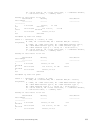
Figure 126. Example of VLT Deployment
VLT on Core Switches
You can also deploy VLT on core switches.
Uplinks from servers to the access layer and from access layer to the aggregation layer are bundled in
LAG groups with end-to-end Layer 2 multipathing. This set up requires “horizontal” stacking at the access
layer and VLT at the aggregation layer such that all the uplinks from servers to access and access to
aggregation are in Active-Active Load Sharing mode. This example provides the highest form of
resiliency, scaling, and load balancing in data center switching networks.
The following example shows stacking at the access, VLT in aggregation, and Layer 3 at the core.
The aggregation layer is mostly in the L2/L3 switching/routing layer. For better resiliency in the
aggregation, Dell Networking recommends running the internal gateway protocol (IGP) on the VLTi VLAN
to synchronize the L3 routing table across the two nodes on a VLT system.
Enhanced VLT
An enhanced VLT (eVLT) configuration creates a port channel between two VLT domains by allowing two
different VLT domains, using different VLT domain ID numbers, connected by a standard link aggregation
control protocol (LACP) LAG to form a loop-free Layer 2 topology in the aggregation layer.
This configuration supports a maximum of four units, increasing the number of available ports and
allowing for dual redundancy of the VLT. The following example shows how the core/aggregation port
density in the Layer 2 topology is increased using eVLT. For inter-VLAN routing and other Layer 3 routing,
you need a separate Layer 3 router.
Virtual Link Trunking (VLT)
943


















